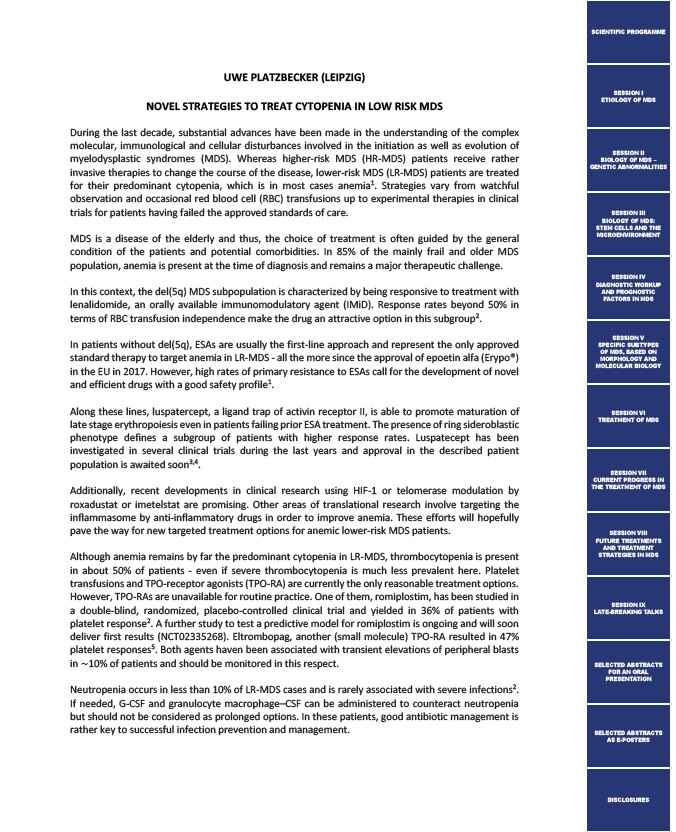
UWE PLATZBECKER (LEIPZIG)
NOVEL STRATEGIES TO TREAT CYTOPENIA IN LOW RISK MDS
During the last decade, substantial advances have been made in the understanding of the complex
molecular, immunological and cellular disturbances involved in the initiation as well as evolution of
myelodysplastic syndromes (MDS). Whereas higher-risk MDS (HR-MDS) patients receive rather
invasive therapies to change the course of the disease, lower-risk MDS (LR-MDS) patients are treated
for their predominant cytopenia, which is in most cases anemia1. Strategies vary from watchful
observation and occasional red blood cell (RBC) transfusions up to experimental therapies in clinical
trials for patients having failed the approved standards of care.
MDS is a disease of the elderly and thus, the choice of treatment is often guided by the general
condition of the patients and potential comorbidities. In 85% of the mainly frail and older MDS
population, anemia is present at the time of diagnosis and remains a major therapeutic challenge.
In this context, the del(5q) MDS subpopulation is characterized by being responsive to treatment with
lenalidomide, an orally available immunomodulatory agent (IMiD). Response rates beyond 50% in
terms of RBC transfusion independence make the drug an attractive option in this subgroup2.
I
n patients without del(5q), ESAs are usually the first-line approach and represent the only approved
standard therapy to target anemia in LR-MDS - all the more since the approval of epoetin alfa (Erypo®)
in the EU in 2017. However, high rates of primary resistance to ESAs call for the development of novel
and efficient drugs with a good safety profile1.
Along these lines, luspatercept, a ligand trap of activin receptor II, is able to promote maturation of
late stage erythropoiesis even in patients failing prior ESA treatment. The presence of ring sideroblastic
phenotype defines a subgroup of patients with higher response rates. Luspatecept has been
investigated in several clinical trials during the last years and approval in the described patient
population is awaited soon3,4.
Additionally, recent developments in clinical research using HIF-1 or telomerase modulation by
roxadustat or imetelstat are promising. Other areas of translational research involve targeting the
inflammasome by anti-inflammatory drugs in order to improve anemia. These efforts will hopefully
pave the way for new targeted treatment options for anemic lower-risk MDS patients.
Although anemia remains by far the predominant cytopenia in LR-MDS, thrombocytopenia is present
in about 50% of patients - even if severe thrombocytopenia is much less prevalent here. Platelet
transfusions and TPO-receptor agonists (TPO-RA) are currently the only reasonable treatment options.
However, TPO-RAs are unavailable for routine practice. One of them, romiplostim, has been studied in
a double-blind, randomized, placebo-controlled clinical trial and yielded in 36% of patients with
platelet response2. A further study to test a predictive model for romiplostim is ongoing and will soon
deliver first results (NCT02335268). Eltrombopag, another (small molecule) TPO-RA resulted in 47%
platelet responses5. Both agents haven been associated with transient elevations of peripheral blasts
in ∼10% of patients and should be monitored in this respect.
Neutropenia occurs in less than 10% of LR-MDS cases and is rarely associated with severe infections2.
If needed, G-CSF and granulocyte macrophage–CSF can be administered to counteract neutropenia
but should not be considered as prolonged options. In these patients, good antibiotic management is
rather key to successful infection prevention and management.
SCIENTIFIC PROGRAMME
SESSION I
ETIOLOGY OF MDS
SESSION II
BIOLOGY OF MDS –
GENETIC ABNORMALITIES
SESSION III
BIOLOGY OF MDS:
STEM CELLS AND THE
MICROENVIRONMENT
SESSION IV
DIAGNOSTIC WORKUP
AND PROGNOSTIC
FACTORS IN MDS
SESSION V
SPECIFIC SUBTYPES
OF MDS, BASED ON
MORPHOLOGY AND
MOLECULAR BIOLOGY
SESSION VI
TREATMENT OF MDS
SESSION VII
CURRENT PROGRESS IN
THE TREATMENT OF MDS
SESSION VIII
FUTURE TREATMENTS
AND TREATMENT
STRATEGIES IN MDS
SESSION IX
LATE-BREAKING TALKS
SELECTED ABSTRACTS
FOR AN ORAL
PRESENTATION
SELECTED ABSTRACTS
AS E-POSTERS
DISCLOSURES